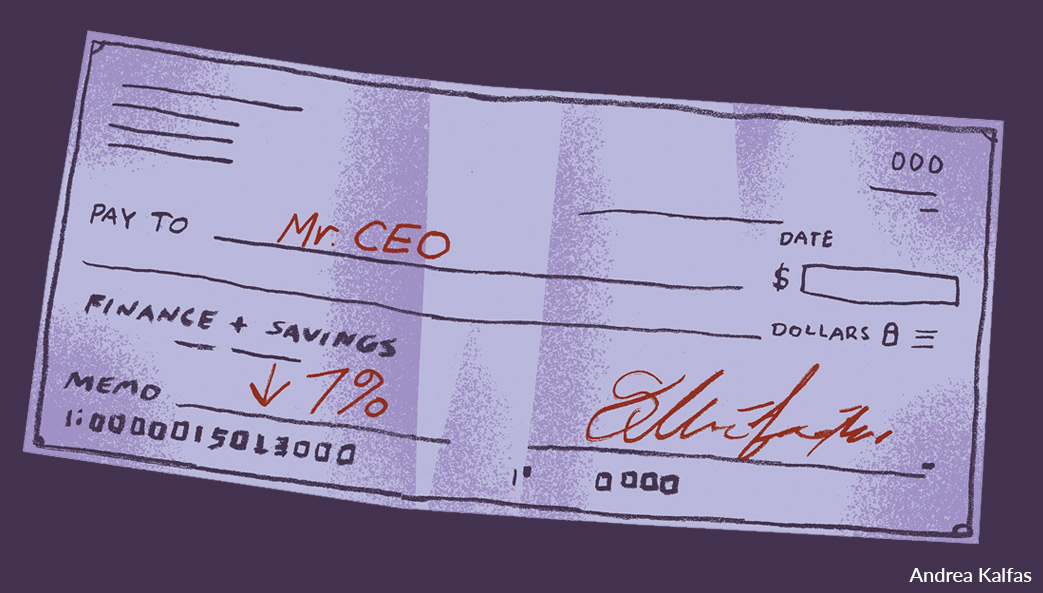Say-on-pay laws are doing their job

By Matt Weeks
Illustration by Andrea Kalfas
During 2016, the CEOs of America’s 350 largest firms made an average of $15.6 million—271 times more than a typical worker in the same year—according to the Economic Policy Institute.
It would seem that not much has changed in the seven years since the Dodd-Frank Wall Street Reform and Consumer Protection Act was signed into law. Dodd-Frank, as it is called, included a “say-on-pay” provision requiring that company shareholders have a chance to vote on executive compensation packages. Such laws were first passed in the United Kingdom and quickly spread across the globe following the Great Recession, partly in response to public unhappiness with what many saw as exorbitant CEO salaries.
But research from UGA finance professor Ugur Lel has revealed that when shareholders have a say on executive pay, CEO salaries decline and the worth of a business increases.
By analyzing financial data from more than 17,000 companies in 38 countries that have passed say-on-pay laws and countries that haven’t, Lel discovered that such laws tie CEO compensation more closely to their company’s performance. The research was published in the Journal of Financial Economics.
“Eleven developed countries passed these laws between 2003 and 2013, so that gave us a natural laboratory where we could see what effect these laws actually had,” he said. “We found that, on average, CEO pay declined by about 7 percent and its sensitivity to firm performance increased by 5 percent.”

“We were surprised to find that after the laws were passed, there was still an increase in CEO pay. Critics argue that the pay increase means the laws are ineffective. That observation is correct, but the interpretation is wrong,” said Lel, who holds the Nalley Distinguished Chair in Finance at the Terry College of Business. “What we see is that while CEO pay still goes up, it actually increases at a lower rate after say-on-pay laws are enacted.”
The decline in CEO pay is more pronounced at companies with poor performance, he added. Firms in the bottom quartile (based on profitability) saw CEO salaries fall by 9.1 percent following say-on-pay passage. Changes in CEO compensation were also more pronounced in firms with problematic pay practices. For example, executive salaries fell by an average of 18.5 percent in companies with “excess pay.”
“There are times when you want to pay a CEO excessively, such as when he or she is doing a really great job and you don’t want them to leave,” Lel said. “But there are other times when you don’t, such as when the firm is losing a lot of money and CEOs haven’t made a difference. After say-on-pay laws happened, we found that excess pay decreased, especially in firms where chief executives had more power.”
Say-on-pay laws also helped company valuations rise—a trend that surprised market watchers.
“The argument against this was that you shouldn’t give more power to shareholders because many may not know a lot about the firm and how it operates,” Lel said. “But it turns out that almost all of the rejection votes come from sophisticated investors. So, these say-on-pay laws work and they empower investors.”
Not all say-on-pay laws are equal. Some are “binding,” meaning the shareholder vote must influence the pay practices, while others stipulate only that the vote must be held. In both cases, however, CEO pay is affected, according to the study.
“It turned out that there was not much difference between binding and non-binding laws. In the U.S., for instance, Dodd-Frank is non-binding but it still shows all of these effects,” Lel said. “Even if 5 percent of shareholders vote against raising CEO pay, it will still have an impact because firms want to be proactive in the area so as not be labeled negatively.”
This story appeared in the fall 2017 issue of Research Magazine. The original press release is available at http://news.uga.edu/releases/article/say-on-pay-laws-are-doing-their-job-uga-study-finds/.
